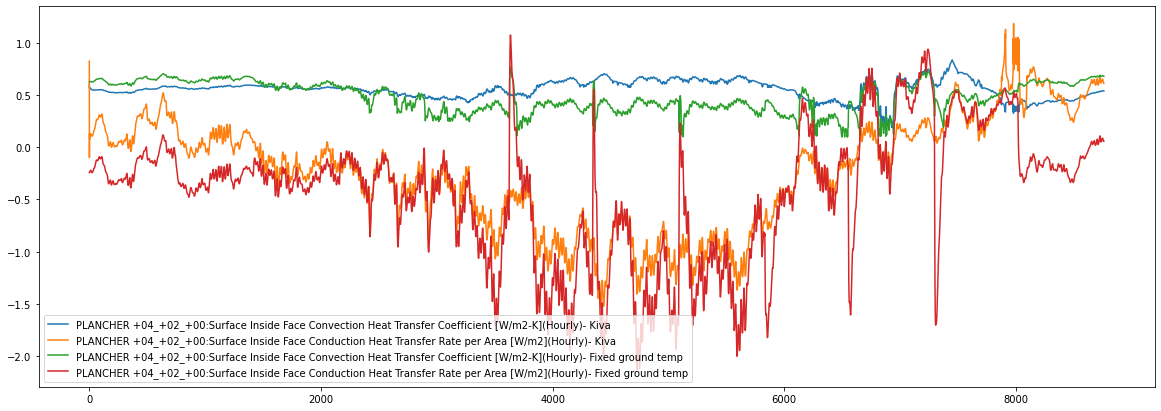Why Kiva results seems to reduce heat needs
I model a single storey building with a big surface (15 744m²) heated to 15°C. The building has the following insulation: floor: 0.24 K.m²W-1; walls: 2.98 K.m²W-1; roof: 6.07K.m².W-1.
I use Kiva foundations with the following parameters:
Foundation:Kiva,
Slab Details, !- Name
15, !- Initial Indoor Air Temperature
, !- Interior Horizontal Insulation Material Name
, !- Interior Horizontal Insulation Depth
, !- Interior Horizontal Insulation Width
, !- Interior Vertical Insulation Material Name
, !- Interior Vertical Insulation Depth
, !- Exterior Horizontal Insulation Material Name
, !- Exterior Horizontal Insulation Depth
, !- Exterior Horizontal Insulation Width
, !- Exterior Vertical Insulation Material Name
, !- Exterior Vertical Insulation Depth
, !- Wall Height Above Grade
, !- Wall Depth Below Slab
; !- Footing Wall Construction Name
Foundation:Kiva:Settings,
1.8, !- Soil Conductivity
3200, !- Soil Density
836, !- Soil Specific Heat
0.9, !- Ground Solar Absorptivity
0.9, !- Ground Thermal Absorptivity
0.03, !- Ground Surface Roughness
40, !- FarField Width
GroundWater, !- DeepGround Boundary Condition
10; !- DeepGround Depth
SurfaceProperty:ExposedFoundationPerimeter,
PLANCHER +00_+00_+00, !- Surface Name
ExposedPerimeterFraction, !- Exposed Perimeter Calculation Method
, !- Total Exposed Perimeter
1, !- Exposed Perimeter Fraction
; !- Surface Segment 1 Exposed
The simulation gives 87MWh of heating over the whole year(ie. 5.4kWh/m²/year).
Secondly, I simulate the same building but with fixed ground temperature with the monthly median of the inside face temperature of the floor of the previous Kiva simulation (taken in the middle of the building). The simulation gives 100 MWh of heating over the whole year(ie. 6.35kWh/m²/year).
I expected the contrary because the second simulation takes the inside face temperature as the ground surface temperature (moreover on the center of the building floor). It seems that the comportement is worse when I use the procedure but with 18°C for the temperature set point.
Details: 192m x 82m (a surface of 15 744m²) with 3 meters of height. The building got 10 x 5 parts (19.2m x 8.2m each).
IDF and EPW:
https://drive.google.com/drive/folder...
Udated
It's like there is less exchanges when I use the Kiva model for the ground. Please look at the graph representing the floor surface conduction heat transfert:
 In the fixed ground temperature IDF there is to material layers for the floor: concrete + Insulation, but in the Kiva IDF I just put one layer with the insulation because the slab is already the concrete layer.
In the fixed ground temperature IDF there is to material layers for the floor: concrete + Insulation, but in the Kiva IDF I just put one layer with the insulation because the slab is already the concrete layer.
Finally, if I take the maximum of the "Surface Inside Face Temperature C" for each month in the Kiva solution for the second approach, results give me 83.5MWh. That's less than 2% above the Kiva solution.






This is likely because Kiva uses ground temperatures that change each timestep instead of one average ground temperature used for an entire month. With the second approach, you miss the temperature fluctuations within each day.
If I take the maximum of the "Surface Inside Face Temperature C" for each month in the Kiva solution for the second approach, results give me 83.5MWh. That's less than 2% above the Kiva solution... And it's the inside temperature, in the middle of the building.
Can you see if using EnergyPlus 22.1 changes your results much? It includes two significant bugfixes for Kiva.
Results changed a lot with this update, thank you for this advice! I wonder about this results: when I model the building in 50 blocks (10x5) (with really thin walls between each block), it gives 220MWh of heating needs over the year but when I model this same building with only 1 block it gives 144MWh. That's a 50% difference! (With the fixed temperature model the difference of heating needs between a one block building and a 50 blocks building is less than 6%).
@cecile.cr it seems that you have made a new post for this new question regarding changing the number of floor surfaces impacting heating results. Is that correct?